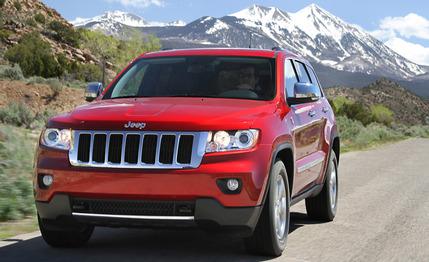
 First Drive Review
First Drive Review
The rocks and desert surrounding Moab, Utah, have seen a lot of things. Dinosaurs hatching, dying, and turning into tar. Mormons fleeing persecution, flourishing, and inspiring a hit HBO show. And Jeeps. Lots and lots and lots of Jeeps. But this is Moab’s first look at the 2011 Jeep Grand Cherokee. Ours, too, at least from behind the wheel.
It’s an eagerly anticipated one, with Chrysler hitting financial rock bottom last year and its new-product pipeline drying up like a desert riverbed under the sweltering summer sun. That makes this Grand Cherokee, the first Jeep product to emerge after the Fiat-Chrysler alliance, a hugely important barometer of vitality and competence for an organization that has displayed little of either for the better part of a decade. The latest Ram and Ram Heavy Duty pickups are good indicators of what Chrysler is still capable of—they’re very good. Hooray for Chrysler, then, that the 2011 Grand Cherokee is good, too.
Based on the same architecture as the Mercedes-Benz M-class, the Grand Cherokee has thoroughly modern running gear. The live axle of the previous generation was tossed in favor of an independent multilink suspension, and civility has taken a commensurate move upward. Even while losing the stick axle, Jeep calls this “the most capable Grand Cherokee ever.” Helping validate that claim is an optional Land Rover–style terrain-selection system, inventively called Selec-Terrain, as well as three different all-wheel-drive systems and an available air suspension.
We spent the better part of a day scrambling up, over, and around nature on Moab’s Hell’s Revenge and Fins and Things trails, which were thick with lifted Jeep CJs, Toyota FJs, and custom-built off-road beasts. The GC acquitted itself very well, a given considering the trails were custom-picked to showcase the SUV’s abilities. Still, we easily conquered super-steep rock faces, craggy stair climbs, and sandy washouts—all with ventilated seats whirring under our butts. The sweaty driver of the 1975 CJ we saw with no doors and a three-legged dog riding shotgun didn’t know what he was missing. We returned to the trailheads suitably impressed.
We drove a Limited model powered by Chrysler’s new Pentastar V-6 and a top-spec Overland with the thundering 5.7-liter Hemi under its hood. (There are also base Laredo and one-step-up Laredo X trims.) Both were equipped with the Off-Road Adventure II package, which adds the air suspension except on the Overland, where it’s standard. The ORA II package also includes a two-speed transfer case, off-road rubber, skid plates, a Trail Rated badge, and the top-dog Quadra-Drive II four-wheel-drive system, although the last item is unavailable with the V-6. Eighteen-inch wheels replace the Overland’s standard and Jeep-first 20-inchers when an off-road pack is specified; 17s are fitted to entry-level Laredos.
So Many Configurations
Before we go any further, let’s break down the various configurations. All trims come standard with the new 3.6-liter 60-degree V-6, which makes 290 hp at 6400 rpm and 260 lb-ft at 4800 rpm, increases of 80 hp and 25 lb-ft over the ancient 90-degree V-6 fitted to the previous GC. The Laredo X, the Limited, and the Overland can then be upgraded to the 360-hp, 5.7-liter Hemi V-8 with 390 lb-ft of torque. A five-speed automatic is the only transmission—we were told a box with more ratios won’t be available until at least the GC’s mid-cycle refresh—and all trims can be paired with rear- or four-wheel drive. Two towing packages allow up to 5000 pounds of towing capability with the V-6 and up to 7400 pounds with the Hemi.
The three four-by-four systems have the same names as before, but they’ve been tweaked. Quadra-Trac I is the basic setup and is only available on Laredo models. It incorporates a single-speed transfer case with a fixed 50/50 torque split front to rear and electronic brake-based torque shunting from side to side. Quadra-Trac II, available on the Laredo X and above, has a two-speed transfer case with a 2.72:1 low range. It can run up to 50 percent of the torque to the front wheels or 100 percent to the rear based on available traction. The Hemi-only Quadra-Drive II setup (there is no QD I), standard on Overlands and available on the Limited and Laredo X, adds an actual electronically controlled limited-slip rear differential.
QT II and QD II come with the Selec-Terrain knob, which sits on the center tunnel and allows the driver to choose among five programs for different conditions: sand/mud, snow, rock, sport, and auto. Depending on the position of the dial, the stability control, the torque transfer, and the transmission react differently, starting in second gear with a fixed 50/50 torque split in snow, for example. Stir in the four-wheel-drive-exclusive air suspension, which can be fitted to all but the base Laredo, and the Grand Cherokee adds five modes of height adjustment to its repertoire. There are 8.1 inches of ground clearance in normal; Off-Road I lifts the GC by 1.3 inches, and Off-Road II adds another 1.3 on top of that. Park mode drops the GC by 1.5 inches for easier loading of people and stuff, and aero mode shaves 0.6 inch from normal’s height to improve fuel economy when traveling above 60 mph. Twiddle the Selec-Terrain knob to sport, and your truck will be in aero mode all the time.